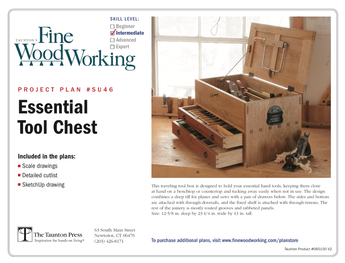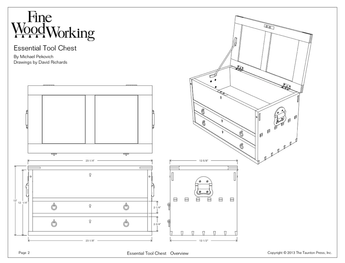I am having issues with larch end grain cutting boards. I plane rough cut boards smooth on both sides, no issues. Then I cut stripes, rotate up and down to get a pattern, then glue the stripes together. TB3, good squeeze out, cure overnight. When I cut this glue up I get glue failures on some interior joints. The ends don’t fail. They interior joints fail at a touch! I will get some pictures shortly.
Discussion Forum
Get It All!
UNLIMITED Membership is like taking a master class in woodworking for less than $10 a month.
Start Your Free TrialCategories
Discussion Forum
Digital Plans Library
Member exclusive! – Plans for everyone – from beginners to experts – right at your fingertips.
Highlights
-
Shape Your Skills
when you sign up for our emails
This site is protected by reCAPTCHA and the Google Privacy Policy and Terms of Service apply. -
 Shop Talk Live Podcast
Shop Talk Live Podcast -
 Our favorite articles and videos
Our favorite articles and videos -
E-Learning Courses from Fine Woodworking
-
-












Replies
What was the temperature of the room where you did the glue up? I find that with titebond I ,II or III temperatures at or below about 55 degrees can be problematic.
Here are two photos - I hope - that show the problem I am having. One picture shows fails in different locations, the other is the joint with glue on both surfaces. This is driving me crazy, when I cut the stripes, I just touched the parts and they just separated, no force required.
Just spitballing ideas here.
Shop glue or wood too cold? I agree with the other poster you need to have air, glue, and materials all warmed up to 55 or 60 min.
I've had something similar happen after doing some cleaning and waxing of my jointer. I didn't buff out the wax enough and the wax transferred causing glue failures.
Are you letting the edge grain board glue up and cure for 24 hours before yo cut them up for end grain? No stress for 24 hours is key.
Couple of Qs:
Are you jointing the first glued up assembly before you do the second glueup? Leftove glue or slight alignment slips from the first assemble can hurt you.
How many of these are you glueing up at once? This type of thing flexes causing uneven clamping pressures even though all seems tight. Putting the strips together one joint at a time and clamped between heavy cauls would be a good thing to try. Clamp from the center out to the ends.
Thanks for the responses. Glue was new last year. Shop temperature was around 50 degrees. The assembly sat for 5 days before I recut it. I applied TB3 to one side of the stripes, made sure there was enough, rubbed glue piece gently to adjacent piece, then continued until all were done. I used 5 parallel clamps, started at the center, up down, to one end, then repeated to other end. No calls on this glue up but definitely one the final end grain one.
I have attached two more pictures, one showing where the failures occurred on this assembly and the other showing typical stripes unassembled.
As an aside note I can't tell you how much I enjoy taking pictures on two devices, uploading them, learning how to resize them, and finally attaching them to this note. Keeps you young.
Thanks again for your suggestions.
I have a local hardware store, they sell glue. I don't buy it there because they don't sell that much. They buy by the case ,some is on the shelf some in the store room. I write the date I buy stuff like glue and finishing materials on the container and purge my stuff when I think it's old. Most glue products I give about a year and then toss. I figure that it's possible that the glue on the store shelf could be a year old before I buy it. I try to purchase my glue where they do high volume, like on line or a big box store. Just because it's new to you doesn't mean that it's fresh new glue. The should print the date of manufacture on the containers. You could have a bad batch. Or what you have has been over heated or frozen at some point....
Someone mentioned pollution. Over waxed a jointer,--- silicone sprays can be particularly bad in that regard. Silicone in any form has been banned at the Martin guitar factory because once it is loose in the shop its difficult or impossible to get rid of. Was causing fisheye in the finishing department- so don't wear your Crocks to work at Martin guitars. Spraying a saw blade or table to reduce drag may be counter productive.
One would not think that you would need to wipe with acetone before glueing given the material that your using but ......you are having failure. I still go with bad glue or too cold. I have built a tent with a small space heater over work that is glued. I like a lower temperature for assembly but I aim for about 70 degrees f for setting. I use alot of plastic resin glue and it requires higher temperatures and a long set time so I have to create a consistent environment that I can't guarantee in the shop but a tent made up of moving mats works really well. I found a really compact oil filled radiator type heater that seems pretty safe in regards to potential ignition.
Applying glue to only one side could also be the issue.